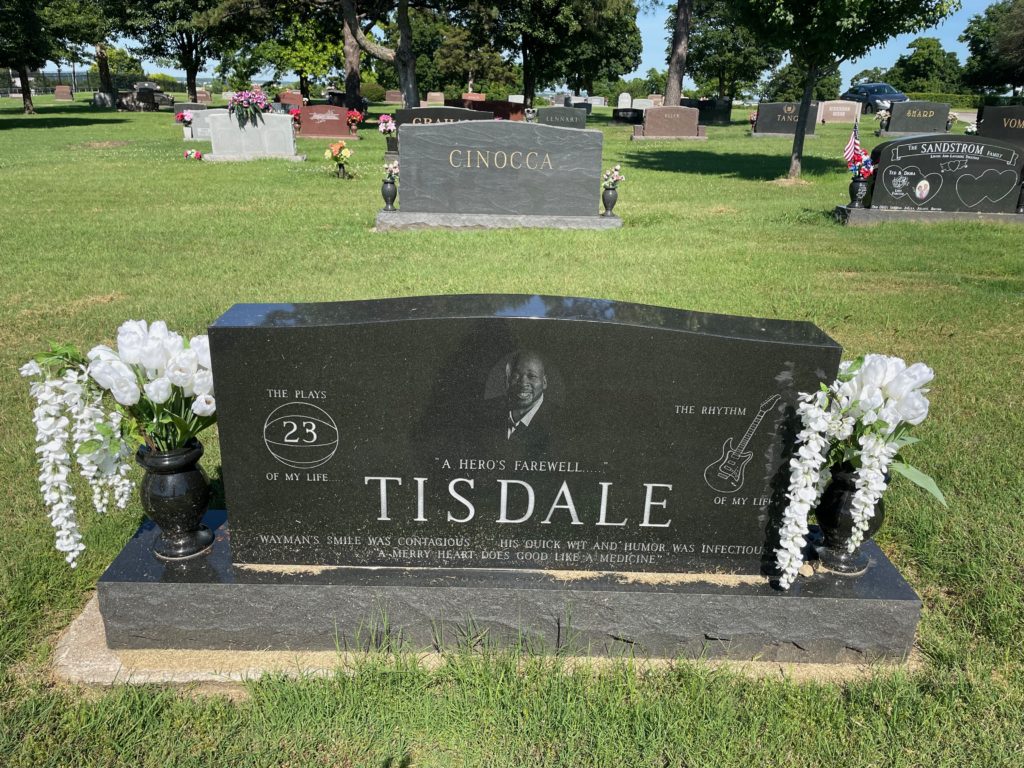Erik Visits an American Grave, Part 1,039
This is the grave of Wayman Tisdale.

Born in Fort Worth, Texas in 1964, Tisdale grew up in the church in Tulsa. His father was a well-known pastor up there. His family also played a lot of basketball. He was kind of whatever about it though until he grew to be a very big kid and learned he could dunk. That appealed, as one might expect. He started taking the game seriously and became very good at it. He was also a good musician. As was often the case in Black churches, his father’s church had a good band that played during the service. Young Wayman took up the bass and played it. He liked that better than hoops for quite awhile.
Tisdale might have been slow to the game, but he sure picked up on it. By the time he was a junior in high school, he was one of the best players in the country and was nationally recruited. Oklahoma nabbed him. Billy Tubbs did this by playing to Tisdale’s religion. Seriously–he changed the team’s entire practice schedule so that Tisdale could attend church at his father’s church in Tulsa. No short drive from Norman to Tulsa.
Tisdale was dominant with the Sooners. A smooth 6’9″ forward, he could do just about anything. He was totally awesome by the time from the moment he stepped on the court. As a freshman, he was named as a AP First Team All-American and then again in his next two years. No one had ever done that before and probably ever will again with the one-and-done structure of college basketball today. He was named the Big Eight Player of the Year in 1983 and then did the same in 1984 and 1985. He was named to the Olympic Team in 1984 when it was still an “amateur” thing and they won the gold in Los Angeles. Other members of that team were Patrick Ewing, Michael Jordan, Chris Mullin, Sam Perkins, Alvin Robertson, and Joe Kleine. A lot of talent there.
Tisdale left the Sooners after the 1985 season. The Indiana Pacers picked him second in the draft. But you know, Tisdale was mostly just OK as a professional player. He was a solid, important contributor. But he wasn’t the great stud that people thought he would be. He could always put the ball in the bucket, but he peaked early and never really got better. He averaged 14.7 points a game as a rookie. Given that his career average was 15.3, he was kind of the same every year. Frustrated with his lack of dominance, the Pacers traded him to the Sacramento Kings in the middle of the 1998-99 season. He was about the same with the Kings, a bad team where he could score a lot but not really dominate. He did get that scoring average up to 22.3 a game in the 89-90 season. He was a decent rebounder as well, usually averaging over 7 a game. But it just never added up to being more than a good numbers guy. He stayed with the Kings through the 94 season. He then signed with the Phoenix Suns. He played three more years and started to decline. He retired after the 1996-97 season when he scored only 6.5 points a game. You can’t call Tisdale a failure as an NBA player but he most certainly was not worth that second draft pick. To be fair to the Pacers though, that whole draft, after Ewing was drafted 1st and before Chris Mullin went 7th, was filled with disappointment–Tisdale was followed by Benoit Benjamin, Xavier McDaniel, Jon Koncak, and Joe Kleine. Pretty meh. Picking Karl Malone might have worked out…..but he was a small school guy and so didn’t go until the Jazz picked him 13th.
However, by the end of his career, Tisdale was also returning to his first love–music. Doing a smooth jazz-funk thing–very much not my thing but whatever–he recorded a number of albums starting with Power Forward in 1995 and In the Zone in 1996. This was seen as a weird anomaly–who knew of basketball players recording albums other than Shaq pretending like he could rap? So between the style and the novelty, his first album actually reached #4 on the Billboard Jazz chart. He continued recording albums for the rest of his life.
Alas, that life was cut short by cancer. He was diagnosed with bone cancer after he fell and broke his leg at home in 2007. The doctors didn’t really know how much chemo to give to a man that size, so it wasn’t super effective. In 2008, he lost part of his leg, but the cancer came back. His esophagus finally ruptured from all the chemo and this killed him in 2009, at the age of 50. Yuck.
Wayman Tisdale is buried in Memorial Park Cemetery, Tulsa, Oklahoma.
If you would like this series to visit other people picked in the 1985 NBA Draft, you can donate to cover the required expenses here. Steve Harris, drafted 19th by the Rockets but who was pretty disappointing, is in Broken Arrow, Oklahoma and Mike Brittain, drafted 29th by the Spurs but who proceeded to drink himself into the ground, is in Clearwater, Florida. Previous posts in this series are archived here.


